
The Court House Hill–Downtown Historic District is a national historic district located in Lynchburg, Virginia. The area is situated on a promontory overlooking the Lower Basin Historic District on the south bank of the James River. The approximately 50-acre (200,000 m2) district is composed of relatively intact city blocks of religious, commercial, residential, and governmental buildings and structures ranging in date from the early 19th century to the mid-20th century. Buildings in the district represent a variety of styles from the different periods, including the Federal, Greek Revival, Gothic Revival, Italianate, Queen Anne, Neoclassical, Italian Renaissance, Spanish Eclectic, Craftsman, and Art Deco styles.

Farmville Historic District is a national historic district located at Farmville, Prince Edward County, Virginia. It encompasses 246 contributing buildings and 1 contributing object in the central business district and surrounding residential areas of Farmville. It includes a variety of commercial, residential, institutional, and industrial buildings dating from the mid-19th to early-20th centuries. Notable buildings include the Paulett-Gill house, Farmville Presbyterian Church, Johns Memorial Episcopal Church (1881), Farmville Methodist Church (1907), Hotel Weyanoke (1925), the warehouses of the Dunnington Tobacco Company and Central Virginia Processing, Inc., the former Craddock-Terry Shoe Company, the former Cunningham and Company tobacco prizery, Norfolk and Western Railroad passenger station, Doyne Building, the Watkins M. Abbitt Federal Building (1917), Prince Edward County Courthouse, and the former Farmville High School (1913). Located in the district is the separately listed First Baptist Church.

The Clarksville Historic District is a national historic district located at Clarksville, Mecklenburg County, Virginia. It encompasses 171 contributing buildings, 2 contributing sites, and 1 contributing structure in the central business district and surrounding residential areas of the town of Clarksille. Notable buildings include the Planters Bank (1909), Planters Brick Tobacco Sales Warehouse, Gilliland Hotel, the Russell's Furniture, former Clarksville High School (1934), Clarksville Presbyterian Church, Mount Zion Baptist Church, Jamieson Memorial Methodist Episcopal Church (1901), St. Timothy's Episcopal Church (1917), and St. Catherine of Siena Roman Catholic Church (1947). Located in the district are the separately listed Clark Royster House and the Judge Henry Wood Jr. House.
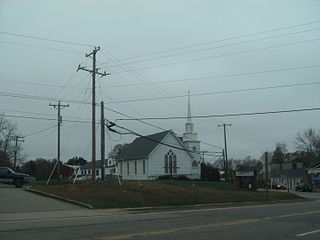
Cumberland Court House Historic District is a national historic district located at Cumberland, Cumberland County, Virginia. The district encompasses 111 contributing buildings, 5 contributing sites, and 8 contributing objects in the county seat of Cumberland County, Virginia. It includes the governmental core of the village and the residential, commercial, educational, and religious resources that have grown up around the courthouse since Cumberland's designation as the county seat in 1777. In addition to the separately listed Cumberland County Courthouse complex, notable buildings include Burleigh Hall, Woodlawn, Center Presbyterian Church (1852), Red Rose Inn, Stewart-Crockett House, All Saints Episcopal Church, Larkin Garrett House (1903), Flippen-Crawley House (1905), Joseph Carpenter House (1903), Masonic Lodge #283 (1903), and Payne Memorial United Methodist Church (1914).

Clifton Historic District is a national historic district located at Clifton, Fairfax County, Virginia. It encompasses 62 contributing buildings, 1 contributing site, and 1 contributing object in the town of Clifton. They include 53 residences, 3 churches, 4 commercial buildings, and 2 local government buildings mostly built between 1880 and 1910. Notable buildings include the Clifton Presbyterian Church (1871), Clifton Baptist Church (1912), Clifton Hotel (1869), the Mayhugh Tavern, the Ford House, the Cross House, Buckley Brothers Store, the M. M. Payne House (1903), and "Red Gables" (1908).

Upperville Historic District is a national historic district located at Upperville, Fauquier County, Virginia. It encompasses 75 contributing buildings in the rural village of Upperville. The district includes residential, commercial, and institutional buildings that mostly date to the first half of the 19th century. Notable buildings include the Joseph Carr houses, the Doctor Smith House (1830s), the United Methodist Church (1833), the Upperville library (1826), and the Baptist Church (1889).

Town of Halifax Court House Historic District is a national historic district located at Halifax, Halifax County, Virginia. The district includes 172 contributing buildings, 1 contributing site, 13 contributing structures, and 1 contributing object in the Town of Halifax. Resources include government, commercial, residential, religious, educational and industrial buildings that date from the early-19th Century to the mid-20th century. Notable buildings include the Rice House, Edmunds/Lewis Office (1869), People's Bank, Beth Car Baptist Church (1892), Christ Episcopal Church, Saint Luke's Christian Methodist Episcopal Church, Dr. Carter House, County Office Building (1915), Town of Halifax Swimming Pool (1930s), Municipal Building/ Fire Station (1950), Halifax Roller Mills (1915), Halifax Planing Mill, Halifax Department Store (1949), and Randolph Theater. Also located in the district is the separately listed Halifax County Courthouse.
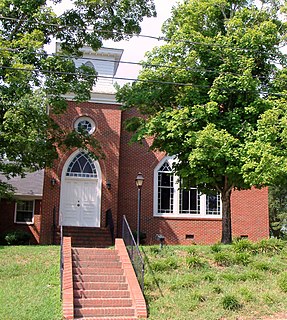
The Boydton Historic District is a national historic district located at Boydton, Mecklenburg County, Virginia. It encompasses 199 contributing buildings, 6 contributing sites, 6 contributing structure, and 2 contributing objects in the central business district and surrounding residential areas of the town of Boydton. Notable buildings include the municipal building (1905), the old jail (1870), the Beales, Bedinger, and Gregory, Inc. car dealership building (1918), Washington Tavern, Williams and Goode Bank (1908), Boydton Department Store (1935), Mecklenburg County Building Department (1949), Southside Regional Library (1939), Presbyterian Meeting House (1819), Saint James Episcopal Church (1840-1841), Boydton Baptist Church, Trinity Episcopal Church (1890s), "Cedar Crest" (1825), and "On the Hill" (1920), which was separately listed in 2015. Also located in the district and separately listed are the Boyd's Tavern and Mecklenburg County Courthouse.

Blacksburg Historic District is a national historic district located at Blacksburg, Montgomery County, Virginia. The district encompasses 137 contributing buildings and 2 contributing sites in the central business district and surrounding residential areas of the town of Blacksburg. The district includes commercial, residential, and institutional buildings in a variety of popular architectural styles including Greek Revival, Gothic Revival, and Colonial Revival. Notable buildings include the Johnson House, Blacksburg Presbyterian Church #1 (1847), Smith-Montgomery House, Croy House, Spout Spring House, Deyerle's Store (1875-1877), W. B. Conway Building, Presbyterian manse (1907), Sheriff Camper House, Christ Episcopal Church, African Methodist Episcopal Church of Blacksburg, Blacksburg Presbyterian Church (1904), Blacksburg Methodist Church (1910), St. Mary's Catholic Church, Hunter's Lodge Masonic Building (1928), Martin-Logan Store, Lyric Theater (1922), and Ellett's Drug Store (1900).

Chatham Historic District is a national historic district located at Chatham, Pittsylvania County, Virginia. The district includes 188 contributing buildings, 2 contributing sites, and 1 contributing object in the central business district of the town of Chatham. The district includes a variety of government, commercial, residential, religious and educational buildings and structures dating from the early-19th century to the mid-20th century. At the center of the district is the separately listed Pittsylvania County Courthouse. Other notable buildings include the Judge Tredway House, Tunstall-Hargrave House, The Oaks (1832), Morea (1837), Hugh Weir House (1835), Planter's Bank, Thompson's Drug and Haberdashy Building, Corinth Christian Church, Emmanuel Episcopal Church (1881), Chatham Presbyterian Church (1886), Canada-Melton House, United States Post Office, Chatham High School, Chatham Elementary School (1925), Chatham Savings Bank, Masonic Temple, Collie Hotel/William Pitt Hotel, Beauty Plaza, and the Moses Building. Also located in the district and separately listed are the Clerk's Office, Bill's Diner, and Burnett's Diner.

Falmouth Historic District is a national historic district located at Falmouth, Stafford County, Virginia. The district includes 29 contributing buildings in the historic core of the town of Falmouth. Notable buildings include Basil Gordon Warehouse, Customs House, the Double House, Highway Assembly of God Church, old Post Office, Calvary Pentecostal Tabernacle, the Tavern, Tavern Keeper's House, Union Methodist Church, Master Hobby School, and the Counting House. Located in the district are the separately listed Gari Melchers Home, Carlton, Clearview and Conway House.
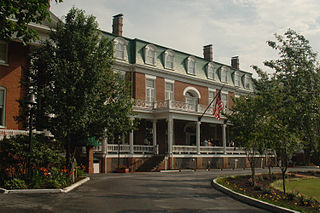
Abingdon Historic District is a national historic district located at Abingdon, Washington County, Virginia. The district encompasses 145 contributing buildings, 2 contributing site, and 13 contributing structures in the town of Abingdon. It includes a variety of residential, commercial, and institutional buildings dating from the late-18th century to the mid-20th century. Notable contributing resources include Sinking Spring Cemetery, William King High School (1913), General Francis Preston House (1832), Martha Washington Inn, Barter Theatre, the Virginia House, Alexander Findlay House (1827), Gabriel Stickley House, Ann Berry House, Washington County Courthouse (1868), Rev. Charles Cummings House, and James Fields House (1857). Located in the district and separately listed are the Abingdon Bank and Dr. William H. Pitts House.

Charlottesville and Albemarle County Courthouse Historic District, also known as the Charlottesville Historic District is a national historic district located at Charlottesville, Virginia. The district encompasses the previously listed Albemarle County Courthouse Historic District and includes 269 contributing buildings and 1 contributing object in the city of Charlottesville. It includes the traditional heart of the city's commercial, civic, and religious activities, with early residential development and industrial sites located along the fringe. The commercial core is located along a seven block Downtown Mall designed by Lawrence Halprin (1916-2009). Notable buildings include the Albemarle County Courthouse, Levy Opera House, Number Nothing, Redland Club, Eagle Tavern, United States Post Office and Courts Building (1906), Christ (Episcopal) Church (1895-1898), Beth Israel Synagogue (1882-1903), Holy Comforter Catholic Church (1925), First Methodist Church (1924), McIntire Public Library (1919-1922), and Virginia National Bank (1916). Also located in the district are the separately listed Abell-Gleason House, William H. McGuffey Primary School, Thomas Jonathan Jackson sculpture, Robert Edward Lee sculpture, and Marshall-Rucker-Smith House.

Centreville–Fentress Historic District is a national historic district located at Chesapeake, Virginia. The district encompasses 24 contributing buildings and 10 contributing structures in a rural farming community that developed a small commercial core. It was developed starting in the 1880s, with the addition of the Norfolk and Elizabeth City Railroad link to the Albemarle and Chesapeake Canal. Notable resources include the Fentress House, Colonial Revival style Centerville Baptist Church (1925), New Burfoot House (1925), Queen Anne style George Jackson House (1890), the Norfolk and Elizabeth City, NC Railroad Tracks, and a 1920 commercial building.

Covington Historic District is a national historic district located at Covington, Virginia. The district encompasses 108 contributing buildings, 1 contributing site, and 1 contributing structure in the historic core of the city of Covington. It includes late-19th and early-20th-century commercial buildings, dwellings that date from around 1820 until 1940, and governmental, educational, religious, industrial, and transportation-related buildings. Notable buildings include Merry Stand, the James Burk House (1824), Callaghan House (1840s), William W. Lawrence House (1850s), Rinehart Building, Covington Savings Bank (1910s), I. O. O. F. Building, Covington Post Office (1914), Hotel Collins (1910), Hippodrome Theater (1920s), C&O Railway and Freight Station (1914-1915), Alleghany County Courthouse (1910), Alleghany County Jail, Sacred Heart Catholic Church, Emmanuel Episcopal Church, First Presbyterian Church (1924), and Covington Baptist Church (1902).

Fayette Street Historic District is a national historic district located at Martinsville, Virginia. It encompasses 116 contributing buildings, in a traditionally African-American section of Martinsville. It includes a variety of commercial, religious, educational and residential buildings dating from the late-19th century through the mid- 20th century. Notable buildings include the Dennis Hairston House, community Market (1925), Mt. Carmel Church, Grace United Presbyterian Church, Albert Harris Intermediate School, Alex Hairston House, Baldwin Block, Watkins-Hairston Funeral Home (1931), Gordon Building (1941), and the Imperial Savings and Loan (1953).
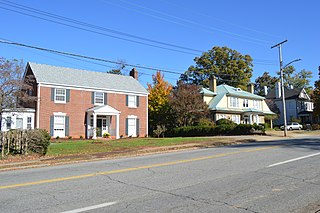
East Church Street–Starling Avenue Historic District is a national historic district located at Martinsville, Virginia. It encompasses 117 contributing buildings, 1 contributing structure, and 1 contributing object in a residential section of Martinsville. The buildings range in date from the range in date from the mid 1880s to the mid-1950s and include notable examples of the Tudor Revival and Colonial Revival styles. Notable buildings include the James Cheshire House, the Obidiah Allen House, John W. Carter House (1896), Christ Episcopal Church (1890s), G.T. Lester House or the “Wedding Cake House” (1918), John W. Townes House, Vaughn M. Draper House, and Martinsville High School (1940) and Gymnasium Building (1928). Located in the district are the separately listed John Waddey Carter House, Scuffle Hill, and the Little Post Office.
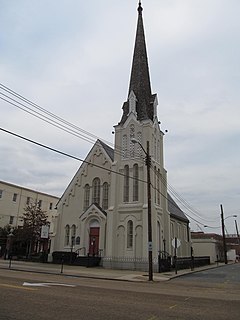
Downtown Portsmouth Historic District, also known as the High Street Corridor Historic District, is a national historic district located at Portsmouth, Virginia. It encompasses 229 contributing buildings, 1 contributing site, 4 contributing structures, and 1 contributing object in the central business district of Portsmouth. The district encompasses the original 1752 plan of the Town of Portsmouth and includes portions of expansions of the original boundaries dating to 1763 and 1909. It includes a variety of commercial, government, and institutional buildings, with most dating to the years around the turn of the 20th century. Notable buildings include the Captain Baird House, Vermillion Manor (1840), City Hall Building (1878), former United States Post Office (1907-1908), First Presbyterian Church (1877), First United Methodist Churches (1882), St. James Episcopal Church, Ebenezer Baptist Church, YMCA building, Tidewater Building, Southern Aid Building, Colony Theater, Lyric Theater, Blumberg's Department Store, Mutual Drug Company (1946), the New Kirn Building, and the Professional Building. Separately listed are the Commodore Theatre, Portsmouth Courthouse, Pythian Castle, St. Paul's Catholic Church, and Trinity Episcopal Church

East Radford Historic District is a national historic district located at Radford, Virginia. It encompasses 302 contributing buildings and 5 contributing structures in a mixed residential and commercial section of Radford, comprising most of the historic boundaries of the town of Central Depot. It was developed between 1866 and 1916, and includes notable examples of Queen Anne and Colonial Revival style architecture. Notable buildings include the Shanks House, the Ward-Carter House, Fraternity Building, Carson's Drug Store, Shumate Store, Alleghany Hotel, Simon Block, Bond Building, Williamson House, Maplehurst, Dobbins Apartments, Belle Heth School, Grove Avenue Methodist Episcopal Church (1913), M. Jackson Hardware Company (1918), and Farmers' and Merchants' Bank.

Downtown Salem Historic District is a national historic district located at Salem, Virginia. The district encompasses 34 contributing buildings and 1 contributing site in downtown Salem. The district includes primarily mixed-use commercial buildings, but also includes churches, dwellings, a courthouse, a post office, a library, a park, and the covered stalls of a farmer's market. The buildings mostly date from the late-19th and early-20th century and are in a variety of popular architectural styles including Greek Revival, Italianate, and Queen Anne. Notable buildings include the Stevens House or "Old Post House" (1820s-1830s), Kizer-Webber Building (1883-1886), Duval-Oakey House (1891-1898), Salem High School, Old Salem Municipal Building and Fire Department (1925), Quality Bakery Building, Olde Newberry Building (1929), Salem Theater, and James J. True Building (1927). Located in the district are the separately listed Old Roanoke County Courthouse, Salem Presbyterian Church, and Salem Post Office.

























